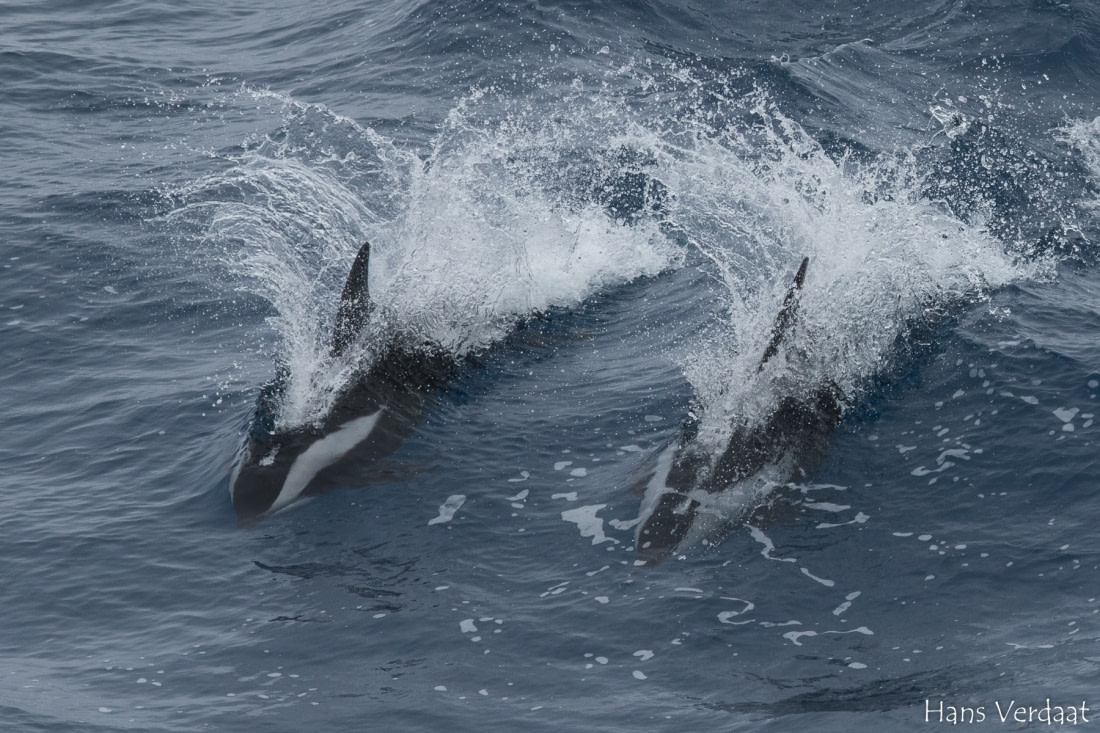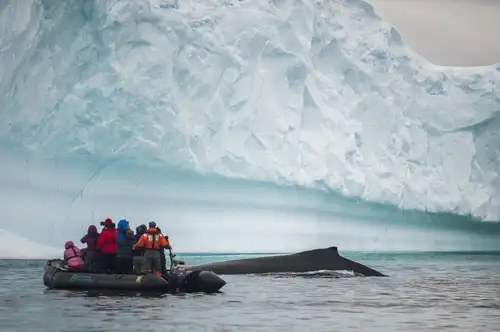Though hourglass dolphins are especially rare, they’re actually not a threatened or endangered species.
This isn’t just luck, however, or some oversight of ecological research.
Rather, it’s due to certain inherent traits of hourglass dolphins. For one, their habitat is the remote, cold Antarctic and sub-Antarctic waters. Also, hourglass dolphins are not hunted commercially. And finally, these timid dolphins tend to avoid human contact.
Small and stocky, with a striking black and white pattern that gives them their common name, hourglass dolphins are one of the least-studied cetaceans in the world.
Scientists still know little about their behavior and biology: As of 2010, less than eight hourglass dolphins had even been studied.

Many names, two habitats, one hourglass dolphin
The scientific name of the hourglass dolphin is Lagenorhynchus cruciger, which means “jar-beaked” and refers to their small, jar-shaped rostrums (beak-like snouts), while cruciger, which means “cross-carrier,” references the unique cross-like color scheme on their flank.
The hourglass dolphin has also been classified as Lagenorhynchus wilsoni, for Edward Wilson, an Antarctic naturalist in the early 20th century.
Other names for hourglass dolphins are as follows: skunk dolphins, Wilson's dolphins, and southern white-sided dolphins. Hourglass dolphins are also nicknamed “sea cows” due to their distinct black and white coloring.
How to identify hourglass dolphins
The coloring of hourglass dolphins sets them apart from other dolphins, but above the Antarctic Convergence they still might be confused with dusky and Peale's dolphins, which are also black and white.
Below the Convergence, however, hourglass dolphins are the only small cetaceans with a dorsal fin, which is tall, hooked, and has a broad base.
Some hourglass dolphins, thought to be adult males, have a marked backward bend approximately halfway up the fin. Their unique coloration and the shape of their fins make it easy to identify these hourglass dolphins.

The southern habitat of hourglass dolphins
Hourglass dolphins are most commonly seen around the Antarctic Convergence, between South America and Macquarie Island.
Their habitat is also known to extend to the south coast of New Zealand, near the South Shetland Islands, and around Tierra del Fuego. The largest concentration of hourglass dolphin sightings, however, has been in the Drake Passage. Hourglass dolphins are usually found in southern waters during the summer and northern waters during the winter. This fluctuating habitat seems to suggest that hourglass dolphins migrate seasonally following cold-water currents.
The large social circle of hourglass dolphins
Gregarious and sociable, hourglass dolphins typically congregate into pods ranging from one to 60 individuals, with their average group size being around seven.
Not only are hourglass dolphins sociable with their own species, but they have also been seen in the company of fin whales, sei whales, southern bottlenose whales, Arnoux's beaked whales, orcas (killer whales), long-finned pilot whales, and southern right whale dolphins.
Hourglass dolphins enjoy bow-riding the waves of these much larger animals and have even been spotted altering their direction to catch the waves of boats and ships.
Swimming in long, low leaps, hourglass dolphins can look like swimming penguins from a distance. Whalers have historically looked for this behavior to identify fin whales.

Hourglass dolphin food facts
Hourglass dolphins feed on lanternfish, squid, and crustaceans, and have been spotted feeding in groups of seabirds and plankton swarms.
They have conical teeth: 26 - 34 in their upper jaws and 27 - 35 in their lower jaws.
Hourglass dolphins use echolocation for orientation and prey location. A recent study, in fact, showed that they produce clicks that allow them to detect prey at more than twice the distance of other dolphin species.
The family life of hourglass dolphins
Little is known about the parental behavior of hourglass dolphins. In studies of their social habits, only three calves were identified out of a group of 1,634 hourglass dolphin adults.
Scientists believe this low offspring number may be explained by the possibility that hourglass dolphins breed during winter, when the weather prevents detailed studies.
However, it may also be due to the tendency of hourglass dolphins to avoid vessels.

Threats to the hourglass dolphin population
Hourglass dolphins are not hunted commercially, have never been systematically exploited, and are almost never caught in fishing nets. Scientists believe the species is probably preyed upon by killer whales, though there is no documented evidence of this.
It is likely, then, that the hourglass dolphin population is near its original levels: 144,300 is the current estimated population. Embark on a thrilling Antarctica cruise to any of our extraordinary sites and enjoy the opportunity to view these beautiful creatures yourself!
Blog



Light in the Land of the Midnight Sun

The secrets of Antarctic seals revealed

10 Books and Films To Prepare for your Antarctica cruise

Svalbard a Disneyland for geologists

The Giant Petrels of King George Island

The Arctic’s Most Phenomenal Fjords

Discover the Scoresby Sund Fjord System in East Greenland

Amphibian, reptiles and herbivore mammals in the Arctic

Arctic and Antarctic Basecamp Cruises – Choose Your Own Adventure

South Georgia Whaling Stations

How Arctic Wildlife Differs from Antarctic

12 photo tips to make better pictures on your Antarctica cruise

A Day of Whale Watching in Antarctica

Freshwater ecosystems in the Arctic

Weddell Sea, Shackleton’s Endurance, and New Swabia

Northeast Greenland National Park

Traditional Lifestyles of the Inuit

Orcas (aka Killer Whales) of Antarctica and the sub-Antarctic

The History of Antarctica in Maps






